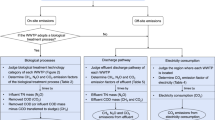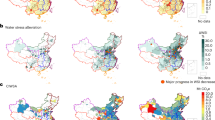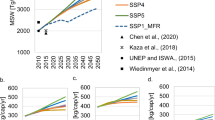Abstract
Greenhouse gas (GHG) emissions from the wastewater sector are a major contributor to the overall GHG emissions of all countries, however, there is currently a lack of global, national-scale, detailed spatiotemporal emission data. In this study we elaborated dynamic plant-resolved emission factor values based on the case-specific operating parameters of each municipal wastewater treatment plant (WWTP) and the associated sewers and sludge disposal utilities in China, contrasting with previous estimations that typically focused on WWTP operation without differentiating their spatiotemporal discrepancies. We demonstrate here that China’s municipal wastewater industry generated 53.0 MtCO2e in total GHG emissions in 2019, with the northern and southern areas exhibiting noticeably higher GHG intensities. Due to improved wastewater treatment, the national average wastewater GHG intensity grew by 17.2% between 2009 and 2019, although it is anticipated that the intensity will begin to fall starting in 2020 at rates dependent on the chosen treatment methods. A net-zero emission by the entire sector may be achieved as early as 2044 with continually increasing decarbonized energy and a progressive shift to resource-oriented operations, compared with just a 23.7% decrease by 2050 under the baseline scenario. Joint efforts at the scientific, economic and policy level will be required to make this happen. This study may serve as a roadmap for developing carbon-neutral wastewater management policies and technologies in China and the rest of the globe.
This is a preview of subscription content, access via your institution
Access options
Subscribe to this journal
Receive 12 digital issues and online access to articles
$99.00 per year
only $8.25 per issue
Buy this article
- Purchase on Springer Link
- Instant access to full article PDF
Prices may be subject to local taxes which are calculated during checkout





Similar content being viewed by others
Data availability
The data generated or analysed during this study are included in this published article and its Supplementary Information files. Supplementary Tables data are also available on Figshare at https://doi.org/10.6084/m9.figshare.21369960. Source data are provided with this paper.
References
Capstick, S., Wang, S. & Khosla, R. Bridging the gap – the role of equitable low-carbon lifestyles. Chap. 6, 1–14 (UNEP, 2020).
Rosa, L., Sanchez, D. L. & Mazzotti, M. Assessment of carbon dioxide removal potential via BECCS in a carbon-neutral Europe. Energy Environ. Sci. 14, 3086–3097 (2021).
McNicol, G., Jeliazovski, J., François, J. J., Kramer, S. & Ryals, R. Climate change mitigation potential in sanitation via off-site composting of human waste. Nat. Clim. Change 10, 545–549 (2020).
Yang, Q. et al. Prospective contributions of biomass pyrolysis to China’s 2050 carbon reduction and renewable energy goals. Nat. Commun. 12, 1698 (2021).
Pan, S.-Y. et al. CO2 mineralization and utilization by alkaline solid wastes for potential carbon reduction. Nat. Sustain. 3, 399–405 (2020).
Lam, K. L. & van der Hoek, J. P. Low-carbon urban water systems: opportunities beyond water and wastewater utilities? Environ. Sci. Technol. 54, 14854–14861 (2020).
Wang, D. et al. Greenhouse gas emissions from municipal wastewater treatment facilities in China from 2006 to 2019. Sci. Data 9, 317 (2022).
Lu, L. et al. Wastewater treatment for carbon capture and utilization. Nat. Sustain. 1, 750–758 (2018).
Li, W.-W., Yu, H.-Q. & Rittmann, B. E. Chemistry: reuse water pollutants. Nature 528, 29–31 (2015).
Gruber, W. et al. N2O emission in full-scale wastewater treatment: proposing a refined monitoring strategy. Sci. Total Environ. 699, 134157 (2020).
Liu, B., Wei, Q., Zhang, B. & Bi, J. Life cycle GHG emissions of sewage sludge treatment and disposal options in Tai Lake Watershed, China. Sci. Total Environ. 447, 361–369 (2013).
Wei, L. et al. Development, current state and future trends of sludge management in China: based on exploratory data and CO2-equivaient emissions analysis. Environ. Int. 144, 106093 (2020).
Hao, X. et al. Environmental impacts of resource recovery from wastewater treatment plants. Water Res. 160, 268–277 (2019).
Yan, X. et al. Spatial and temporal distribution of greenhouse gas emissions from municipal wastewater treatment plants in China from 2005 to 2014. Earths Future 7, 340–350 (2019).
Wang, H. et al. Comparative analysis of energy intensity and carbon emissions in wastewater treatment in USA, Germany, China and South Africa. Appl. Energy 184, 873–881 (2016).
Qu, J. et al. Emerging trends and prospects for municipal wastewater management in China. ACS ES T Eng., https://doi.org/10.1021/acsestengg.1c00345 (2022).
Schneider, A. G., Townsend-Small, A. & Rosso, D. Impact of direct greenhouse gas emissions on the carbon footprint of water reclamation processes employing nitrification–denitrification. Sci. Total Environ. 505, 1166–1173 (2015).
Wastewater treated in vain. Caixin Weekly (2013). http://topics.caixin.com/dirt/ (2021).
Yang, G., Zhang, G. & Wang, H. Current state of sludge production, management, treatment and disposal in China. Water Res. 78, 60–73 (2015).
Yang, Z. et al. Assessment of upgrading WWTP in southwest China: towards a cleaner production. J. Clean. Prod. https://doi.org/10.1016/j.jclepro.2021.129381 (2021).
Zhang, H. et al. A review on China’s constructed wetlands in recent three decades: application and practice. J. Environ. Sci. (China) 104, 53–68 (2021).
Afzal, M. et al. Floating treatment wetlands as a suitable option for large-scale wastewater treatment. Nat. Sustain. 2, 863–871 (2019).
Yu, B. et al. Thermosensitive crystallization-boosted liquid thermocells for low-grade heat harvesting. Science, https://doi.org/10.1126/science.abd6749 (2020).
Solon, K., Volcke, E. I. P., Spérandio, M. & van Loosdrecht, M. C. M. Resource recovery and wastewater treatment modelling. Environ. Sci. 5, 631–642 (2019).
Scherson, Y. D. & Criddle, C. S. Recovery of freshwater from wastewater: upgrading process configurations to maximize energy recovery and minimize residuals. Environ. Sci. Technol. 48, 8420–8432 (2014).
Discharge Standard of Pollutants for Public Wastewater Treatment Plant (Exposure Draft) (People’s Government of Zhejiang Province, 2018).
Discharge Standard of Pollutants for Urban Wastewater Treatment Plant (Exposure Draft) (Ministry of Ecology and Environment of the People’s Republic of China, 2015).
Hao, X. D., Li, J., van Loosdrecht, M. C. M., Jiang, H. & Liu, R. B. Energy recovery from wastewater: heat over organics. Water Res. 161, 74–77 (2019).
Guo, W., Ngo, H. H., Surampalli, R. Y., & Zhang, T. C. Sustainable Resource Management, Volume II: Technologies for Recovery and Reuse of Energy and Waste Materials Vol. 2, 635–662 (Wiley–VCH, 2021).
Su, C., Madani, H., Liu, H., Wang, R. & Palm, B. Seawater heat pumps in China, a spatial analysis. Energy Convers. Manag. https://doi.org/10.1016/j.enconman.2019.112240 (2020).
Hao, X.-D., Fang, X.-M., Li, J. & Jiang, H. Analysis of potential in carbon-neutral operation of WWTPs. China Water Wastewater 34, 11–16 (2018).
Pretel, R., Shoener, B. D., Ferrer, J. & Guest, J. S. Navigating environmental, economic, and technological trade-offs in the design and operation of submerged anaerobic membrane bioreactors (AnMBRs). Water Res. 87, 531–541 (2015).
McCarty, P. L., Bae, J. & Kim, J. Domestic wastewater treatment as a net energy producer—can this be achieved? Environ. Sci. Technol. 45, 7100–7106 (2011).
Schaubroeck, T. et al. Environmental sustainability of an energy self-sufficient sewage treatment plant: improvements through DEMON and co-digestion. Water Res. 74, 166–179 (2015).
Alvarado, V. I., Hsu, S. C., Lam, C. M. & Lee, P. H. Beyond energy balance: environmental trade-offs of organics capture and low carbon-to-nitrogen ratio sewage treatment systems. Environ. Sci. Technol. 54, 4746–4757 (2020).
Sun, Y. et al. Characteristics of water quality of municipal wastewater treatment plants in China: implications for resources utilization and management. J. Clean. Prod. 131, 1–9 (2016).
Ma, C., Jensen, M. M., Smets, B. F. & Thamdrup, B. Pathways and controls of N2O production in nitritation–anammox biomass. Environ. Sci. Technol. 51, 8981–8991 (2017).
Winiwarter, W., Höglund-Isaksson, L., Klimont, Z., Schöpp, W. & Amann, M. Technical opportunities to reduce global anthropogenic emissions of nitrous oxide. Environ. Res. Lett. https://doi.org/10.1088/1748-9326/aa9ec9 (2018).
Hao, X., Liu, R. & Huang, X. Evaluation of the potential for operating carbon neutral WWTPs in China. Water Res. 87, 424–431 (2015).
Van Loosdrecht, M. C. M. & Brdjanovic, D. Anticipating the next century of wastewater treatment. Science 344, 1452–1453 (2014).
Huang, B.-C., Li, W.-W., Wang, X., Lu, Y. & Yu, H.-Q. Customizing anaerobic digestion-coupled processes for energy-positive and sustainable treatment of municipal wastewater. Renew. Sustain. Energy Rev. 110, 132–142 (2019).
Huang, B. C., Lu, Y. & Li, W. W. Exploiting the energy potential of municipal wastewater in China by incorporating tailored anaerobic treatment processes. Renew. Energy 158, 534–540 (2020).
Hao, X., Batstone, D. & Guest, J. S. Carbon neutrality: an ultimate goal towards sustainable wastewater treatment plants. Water Res. 87, 413–415 (2015).
Lovley, D. R. & Holmes, D. E. Electromicrobiology: the ecophysiology of phylogenetically diverse electroactive microorganisms. Nat. Rev. Microbiol. 20, 5–19 (2022).
Fu, X. Z. et al. Self-regenerable bio-hybrid with biogenic ferrous sulfide nanoparticles for treating high-concentration chromium-containing wastewater. Water Res. 206, 117731 (2021).
Cui, S. et al. Light-assisted fermentative hydrogen production in an intimately-coupled inorganic-bio hybrid with self-assembled nanoparticles. Chem. Eng. J. https://doi.org/10.1016/j.cej.2021.131254 (2022).
Zhang, H. et al. Bacteria photosensitized by intracellular gold nanoclusters for solar fuel production. Nat. Nanotechnol. 13, 900–905 (2018).
Predicted national GHGs emission of China in 2030. Climate Action Tracker. https://climateactiontracker.org/countries/china/ (2014).
Urban sewage treatment and resource utilization development plan for the “Fourteenth Five-Year Plan”. National Development and Reform Commission (NDRC). Peoples’s Republic of China; https://en.ndrc.gov.cn/ (2021).
Kovacs, D. P., McCorkindale, W. & Lee, A. A. Quantitative interpretation explains machine learning models for chemical reaction prediction and uncovers bias. Nat. Commun. 12, 1695 (2021).
Nogrady, B. China launches world’s biggest carbon market. Nature 595, 637 (2021).
Mihelcic, J. R. et al. Accelerating innovation that enhances resource recovery in the wastewater sector: advancing a national testbed network. Environ. Sci. Technol. 51, 7749–7758 (2017).
Cole, A. et al. From macroalgae to liquid fuel via waste-water remediation, hydrothermal upgrading, carbon dioxide hydrogenation and hydrotreating. Energy Environ. Sci. 9, 1828–1840 (2016).
Liu, Z. et al. Challenges and opportunities for carbon neutrality in China. Nat. Rev. Earth Environ. 3, 141–155 (2022).
Eggimann, S. et al. The potential of knowing more: a review of data-driven urban water management. Environ. Sci. Technol. 51, 2538–2553 (2017).
Mauter, M. S. & Fiske, P. S. Desalination for a circular water economy. Energy Environ. Sci. 13, 3180–3184 (2020).
National Urban Sewage Treatment Management Information System. Ministry of Housing and Urban-Rural Development of the People’s Republic of China (MOHURD); http://www.mohurd.gov.cn/ (2021).
Gallego-Schmid, A. & Tarpani, R. R. Z. Life cycle assessment of wastewater treatment in developing countries: a review. Water Res. 153, 63–79 (2019).
IPCC Climate Change 2022: Mitigation of Climate Change (eds Shukla, P. R. et al.) (Cambridge Univ. Press, 2022).
Acknowledgements
The authors thank the National Natural Science Foundation of China (52192681, U21A20160, 51821006 and 22265010) for supporting this work.
Author information
Authors and Affiliations
Contributions
W.-J.D., J.-Y.L. and W.-W.L. conceived the idea. J.-Y.L., W.-J.D., Y.-R.H., J.X., C.Y., B.H. and S.C. collected and analysed the data. J.-Y.L., W.-W.L., J.W., Y.W. and W.-J.D. co-wrote the manuscript. All authors discussed the results and commented on the manuscript.
Corresponding author
Ethics declarations
Competing interests
The authors declare no competing interests.
Peer review
Peer review information
Nature Water thanks Stephan Pfister and the other, anonymous, reviewer(s) for their contribution to the peer review of this work.
Additional information
Publisher’s note Springer Nature remains neutral with regard to jurisdictional claims in published maps and institutional affiliations.
Supplementary information
Supplementary Information
Supplementary Notes 1–3, Figs. 1–19 and Tables 1–24.
Supplementary Data
Raw data.
Source data
Source Data Fig. 2
Statistical source data.
Source Data Fig. 3
Statistical source data.
Source Data Fig. 4
Statistical source data.
Source Data Fig. 5
Statistical source data.
Rights and permissions
Springer Nature or its licensor (e.g. a society or other partner) holds exclusive rights to this article under a publishing agreement with the author(s) or other rightsholder(s); author self-archiving of the accepted manuscript version of this article is solely governed by the terms of such publishing agreement and applicable law.
About this article
Cite this article
Du, WJ., Lu, JY., Hu, YR. et al. Spatiotemporal pattern of greenhouse gas emissions in China’s wastewater sector and pathways towards carbon neutrality. Nat Water 1, 166–175 (2023). https://doi.org/10.1038/s44221-022-00021-0
Received:
Accepted:
Published:
Issue Date:
DOI: https://doi.org/10.1038/s44221-022-00021-0
This article is cited by
-
Methane emissions from landfills differentially underestimated worldwide
Nature Sustainability (2024)
-
Research progress and prospect of low-carbon biological technology for nitrate removal in wastewater treatment
Frontiers of Environmental Science & Engineering (2024)
-
Effect of Nitrate Concentration on Anaerobic Methane Oxidation Coupled to Denitrification in Membrane Biofilm Reactor After Prolonged Storage
Water, Air, & Soil Pollution (2024)
-
Decoupling wastewater-related greenhouse gas emissions and water stress alleviation across 300 cities in China is challenging yet plausible by 2030
Nature Water (2023)



